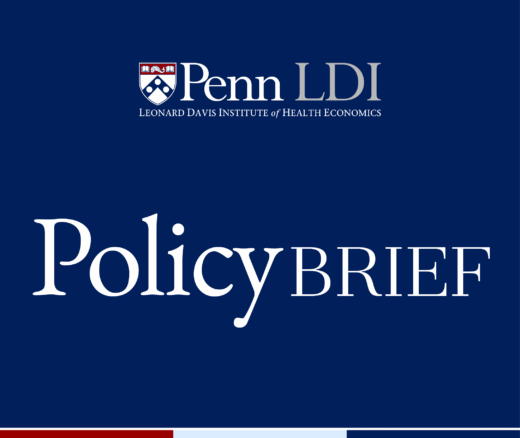
Reforming Long-Term Care Policy
Lessons from the Past, Imperatives for the Future
Improving Care for Older Adults
Blog Post

Nursing homes are among the most strictly regulated segments of the U.S. health care system, yet, for the most part, the minimum federal staffing requirements for direct-care staffers—registered nurses (RNs), licensed practical nurses (LPNs), and certified nursing assistants (CNAs)—are vague and rarely enforced. Prompted by the enormous rate of fatalities among patients and staffers during the COVID-19 pandemic, the Centers for Medicare and Medicaid Services (CMS) has proposed (but not released) rules on tighter staffing ratios for the country’s over 15,000 nursing homes. In the meantime, the state of Pennsylvania has come up with its own set of rules that went into effect on July 1. The new regulations state that nursing home patients must receive 2.87 hours of direct care per day (up from 2.7), a requirement that will grow to 3.2 by July 1, 2024. By contrast, an influential 2022 report from the National Academies of Science, Engineering, and Medicine (NASEM) recommended 4.1 hours per resident day (HPRD).
“Pennsylvania’s regulations to increase nurse staffing levels to 2.87 HPRD are an important step in the right direction, but it’s a small step,” said Rachel M. Werner, Executive Director of the Leonard Davis Institute of Health Economics (LDI). She added, “The new required staffing levels are low and will remain low even after they reach the target of 3.2 HPRD in 2024. These changes will affect only the lowest-staffed nursing homes in the Commonwealth. Improving staffing at these nursing homes is important but is not going to result in sweeping reform in the nursing home sector.”
Updates in the Pennsylvania regulations were “brewing for some time, but COVID-19 accelerated the changes,” said Jeanne Parisi, Deputy Secretary for Quality Assurance in Pennsylvania’s Department of Health (DOH). Using the 4.1 HPRD figure as an ideal starting point, the DOH negotiated with various stakeholders, looking for “the right balance,” according to Parisi. “SEIU Healthcare Pennsylvania, which represents nursing home workers, provided lots of support, while the organizations that represent facilities were more resistant.” The compromise requirements for the 682 nursing home facilities in Pennsylvania are: Starting on July 1, 2023, during the day shift, there must be 1 LPN per 25 residents and 1 CNA per 12 residents. Evening and overnight shifts have lower ratios. At all times, facilities must provide 1 RN per 250 residents. The July 1, 2024 increase comes from a jump in CNA hours. On that day, daytime staffing levels for CNAs will increase to 1 per 10 residents and will grow accordingly for other shifts.
LDI Senior Fellow Atul Gupta, Assistant Professor of Health Care Management at Wharton, approves of the specificity of the new regulations. “The new rules have specified minimum standards for CNAs, LPNs, and RNs separately. I like and support that stipulation since we have found in our work, and others have also shown, that facilities often fire CNAs and LPNs and increase the number of RNs so that their overall staff spend is similar. But it changes things substantially in terms of care for patients since an RN and CNA do very different tasks,” said Gupta.
A recent report from the Kaiser Family Foundation (KFF) says that 86% of Pennsylvania’s nursing homes already comply with the 3 HPRD standard. “I don’t want to comment on specific thresholds. But based on the Kaiser stats, it seems that the new rules are not going to move the needle really for the vast majority of facilities. So, I expect these standards to not change things in practice for most patients,” said Gupta.
However, DOH’s Parisi thinks Kaiser’s 86% figure is too high. “I believe that the new requirements will make a substantial difference in nursing home care,” she said.
“Lower levels of staffing tend to lead to lower quality in nursing homes,” said LDI Senior Fellow Norma Coe, Associate Professor of Medical Ethics and Health Policy at the Perelman School of Medicine and Co-Director of the Population Aging Research Center (PARC). Nursing homes require a large number of employees. RNs and LPNs do the supervisory and medical care (such as giving injections), but the bulk of direct care (such as getting patients out of bed) is provided by CNAs. “CNAs are predominantly female, people of color, immigrants. They make about $10 to $15 an hour,” Coe said.
While the federal government and many states already regulate RN hours, less attention has been paid to CNA staffing, noted Werner. “A loss of direct-care staff, like nurses and aides, can harm patient wellbeing. We know that antipsychotics are sometimes used to sedate patients and may increase in the setting of low staffing levels,” she said. Lower staffing may be connected to COVID-19 infections. In a 2021 cross-sectional study of nursing homes in communities with high COVID-19 prevalence, “facilities with fewer direct patient care hours were more susceptible to virus spread,” said co-author Kira Ryskina, LDI Senior Fellow and Assistant Professor of Medicine at the Perelman School of Medicine.
Nursing homes vary in their staff-to-patient ratios. “In general, for-profit nursing homes have lower staffing levels, and some of the outcomes are not good,” said Ryskina. According to research by Gupta, patients in nursing homes owned by private equity (PE) investors can experience especially poor results. “Our estimates show that PE ownership increases the short-term mortality of Medicare patients by 10%, implying 20,150 lives lost due to PE ownership over our twelve-year sample period. We find that PE ownership leads to a 3% decline in hours per patient-day supplied by the frontline nursing assistants who provide the vast majority of caregiving hours.”
These mandates are happening when there’s “an almost historic crisis on the labor front,” Gupta noted. “Because of labor shortages, enforcement may be more punitive than helpful,” said LDI Senior Fellow Jeffrey Jaeger, Professor of Clinical Medicine at Perelman. One way to deal with difficulties in filling positions is to provide exemptions to nursing homes that are in areas with labor shortages, Ryskina said. A more long-term solution is to improve the salaries of CNAs, suggested Jaeger. Where would the money come from? “I believe that Medicaid pays nursing homes at rates that are too low, leaving nursing homes unable to hire staff and pay them a living wage,” Werner said. In addition, “Immigration enforcement has had a detrimental effect on nursing home staffing. With a decline in the number of nurses and nurse aides born outside of the U.S. who are working in nursing homes, we have exacerbated the existing labor shortages in nursing homes,” Werner said.
New York, Massachusetts, and New Jersey authorities are using an alternative approach to improve staffing ratios. Direct care minimum spending ratios or pass-throughs require that a high percentage of tax-payer funds go to direct patient care rather than to administrative expenses, salaries, profits, or third parties controlled by the nursing homes that provide services such as occupational therapy at higher rates than what the market would normally bear. These regulations are “promising,” said Werner. “They don’t have a lot of evidence behind them, but there is evidence that nursing homes don’t always spend their revenue in ways that directly benefit patient care. Mandating higher spending on direct patient care has a lot of face validity.”
Ryskina emphasizes that staffing mandates are “a very blunt instrument” to improve care and outcomes in nursing home patients. She said, “Direct care workers with decades of experience may be able to provide care more efficiently than their colleagues with less experience. In addition, other nursing home staff and health care team members greatly influence the care provided to nursing home patients. So, if the mandates result in cost cutting in other areas, the ultimate outcomes may not be what is desired. Lastly, patients in nursing homes represent a clinically heterogeneous group—some patients may require a lot more or less care at different times in their stay. Focusing on patient outcomes and satisfaction may be a more effective and adaptive way to improve care quality than mandates.”
Still, noted Werner: “There are a lot of challenges in nursing homes. Improving staffing is one of the foundational changes that would make a difference.” She added, “The Pennsylvania regulations are an important step in the broader (federal) setting where little is happening right now. Changes to the federal minimum staffing standard have stalled out despite nursing homes’ experiences during the COVID-19 pandemic and the very strong recommendations from the National Academies’ report to increase staffing levels. If the federal government is not going to take action on this important issue, it is up to the states to do so.”


Lessons from the Past, Imperatives for the Future

Technology Helps Older Adults Stay at Home—But May Delay Necessary Transitions to Higher Levels of Care

Her Transitional Care Model Shows How Nurse-Led Care Can Keep Older Adults Out of the Hospital and Change Care Worldwide

Direct-to-Consumer Alzheimer’s Tests Risk False Positives, Privacy Breaches, and Discrimination, LDI Fellow Warns, While Lacking Strong Accuracy and Much More

New Therapies Inspire Hope, Even as Access and Treatment Risks Continue to Challenge Patients and Providers

Penn LDI Senior Fellow Yong Chen Is an MPI in the 10-Institution NIA Undertaking

Precision Diagnostics Give Patients Clearer Answers About What Drives Cognitive Impairment

Findings Suggest That Improving Post-Acute Care Means Looking Beyond Caseloads to Nursing Home Quality